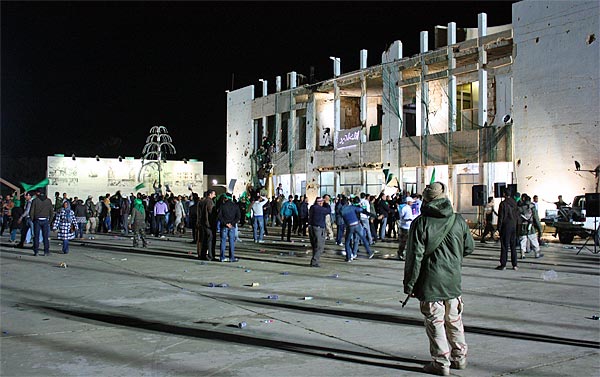Los EE.UU.. and its allies expand their strikes, one of which hits Kadafi’s compound in Tripoli. The Obama administration struggles to define its goals and its role in the attacks.
By Borzou Daragahi and Brian Bennett, Los Angeles Times
The second day of the Western military campaign against Moammar Kadafi saw an escalation of attacks, with bombing raids against ground forces loyal to the Libyan leader — and an escalation of questions on the strikes’ objective and the extent of the U.S. role.
As U.S. officials said that Kadafi was not being targeted in a campaign that has seen his air defenses blasted by cruise missiles, a structure in his massive compound in the Libyan capital, Tripoli, was hit in a missile strike late Sunday.
With antiaircraft fire lighting up the sky, journalists were led to a bus after midnight and driven to the Bab Azizia compound, whose barracks-style buildings, barbed wire and hundreds of young militiamen brandishing semiautomatic weapons give it the look of a Tripoli “Green Zone.”
Sólo 100 yards from the residence that President Reagan bombed a quarter-century ago, y 50 yards from the tent where the flamboyant leader receives dignitaries, a three-story complex had become a mound of wiring and tangled concrete. Metal girders stuck out from where the missile had sheared through the structure.
Journalists rummaging through the wreckage found guidance and control parts consistent with a U.S.-made cruise missile. One piece said it had been manufactured in 2006.
“This attack was in contradiction to what the Americans and others have been saying, that it’s not a priority to hit the leader,” government spokesman Musa Ibrahim said as crowds of Kadafi supporters chanted, “Down, down, U.S.A.,” y, significantly, “Death to Sarkozy,” the French leader who has taken a very public role in the campaign.
Asked about the strike, Vice Adm. William E. Gortney told reporters, “At this particular point I can guarantee he is not on the targeting list.”
In a briefing at the Pentagon, he said it was possible Kadafi could be hit “if he happens to be in a place inspecting a missile site and we don’t have any idea he is there at the time” pero eso “we are not targeting his residence at this time.”
After the initial bombardments, the leader of the Arab League, Amr Moussa, called the overnight campaign “excessive.” Al mismo tiempo, sin embargo, Arab League member state Qatar was moving fighter jets into position to begin flights patrolling over Libya.
In Brazil with President Obama, national security adviser Tom Donilon said the U.S. military role is “very specific,” involving a limited action meant to protect Libyan civilians from Kadafi’s forces, which have been advancing on the eastern rebel stronghold of Benghazi.
The near-term goal of the military exercise is not to force Kadafi from power, White House officials said. Más bien, the administration hopes to “squeeze” him by isolating him diplomatically, peeling away his support and imposing sanctions on his regime, dijeron.
It was only last summer that the U.S. declared an end to combat operations in Iraq. In Afghanistan, where the U.S. is leading a nearly 10-year war that recent polls show most Americans feel is no longer worth fighting, Obama has approved a plan to keep fighting until at least 2014, with no guarantee that by then the government in Kabul can handle security in the country.
But faced with the prospect of a humanitarian disaster at Kadafi’s hands, Obama found himself in the uncomfortable position he has spent weeks trying to avoid: that of world policeman.
El domingo, Republican House Speaker John A. Boehner asked Obama to clarify his objectives in Libya. “Before any further military commitments are made, the administration must do a better job of communicating to the American people and to Congress about our mission in Libya and how it will be achieved,” Boehner said in a statement.
Indiana republicano Sen. Richard G. Lugar reiteró su llamado a una declaración de guerra por parte del Congreso que diseñar un plan para las operaciones. “Siempre debe haber un plan para lo que va a proceder,” Lugar dijo, citando encuestas de que el pueblo estadounidense no quiere asumir retos más caros cuando la nación ya está luchando con el presupuesto, déficit y la economía. Un problema que se enfrenta la administración es que a pesar de que Obama quiere que los EE.UU.. para desempeñar un papel de apoyo en Libia - y, en efecto, la primera huelga vino de un avión de combate francés - sólo Estados Unidos tiene los recursos para poner en marcha las operaciones complejas para eliminar las defensas aéreas de Kadafi.
Pero los detalles acerca de cuándo y cómo el U.S. entregará el liderazgo de la operación eran difícil de alcanzar.
“No sabemos cuándo vamos a estar listos para hacer eso [mano el mando] y no sabemos lo que la estructura se verá como,” Gortney dijo. “Estamos trabajando muy duro para definirlo.”
El secretario de Defensa Robert M.. Gates dijo el domingo que había un par de posibilidades para el futuro liderazgo de la campaña. “Uno de ellos es el liderazgo británico y francés. Otro es el uso de la maquinaria de la OTAN,” Gates dijo a los periodistas mientras volaba a Rusia.
Si los Estados Unidos tomaría nuevas medidas para ayudar a los rebeldes en Libia “queda por ver,” dijo Gates, quien agregó que una partición de Libia sólo contribuiría a “inestabilidad perdurable” en la región. The rebels had swept westward from their eastern base before being chased back to Benghazi by forces loyal to Kadafi.
Los EE.UU.. y sus aliados habían hecho el cálculo de que una falta de intervención podría significar una masacre de civiles en Benghazi, el hogar de 700,000 y la segunda ciudad más grande de Libia, y aumentado los ataques más allá de simplemente preparar el terreno para la implantación de una zona de exclusión aérea. Altos oficiales militares señalaron la frase en la resolución de Naciones Unidas que autoriza a la coalición de utilizar “todas las medidas necesarias” para proteger a los civiles en Libia.
Gortney dijo el domingo que Bengasi no estaba completamente a salvo de los ataques de las fuerzas de Kadafi, “pero sin duda es bajo menos amenaza.”
Los ataques del domingo se llevaron a cabo por 15 EE.UU.. aeronave, including Marine Harrier jets deployed from an assault ship in the Mediterranean and three Air Force B-2 stealth bombers that flew the 25-hour journey from Whiteman Air Force Base in Missouri to drop 45 bombs, each weighing 2,000 libras.
Mientras tanto, the operation’s costs are mounting. Senior Defense officials would not comment on how much the operation has cost so far, saying they were focused on carrying out the mission at hand.
But an independent report released this month by the Center for Strategic and Budgetary Assessments estimated that the no-fly zone would cost at least $400 million to set up, and up to $100 million per week to enforce. Each Tomahawk missile costs more than $500,000, bringing the total price for Saturday night’s initial volley to at least $55 millones de.
“Eso es lo que sucede cuando todo el mundo está recortando su defensa: Vamos a tener que proporcionar la mayor parte de los recursos,” dijo Lawrence Korb, el ex secretario adjunto de la logística bajo Reagan, que en otro tiempo llamada Kadafi “el perro loco de Oriente Medio.”
Las autoridades libias afirman que más de cinco docenas de personas, todos ellos civiles, han muerto en los ataques aéreos, pero no han mostrado evidencia de grandes daños o víctimas civiles.
En Trípoli, Las autoridades llevaron a los periodistas a lo que describieron como la playa de la ciudad “mártires” cementerio, en un intento de justificar las cifras oficiales de muertos.
Los periodistas se reunieron con la ira de cientos de manifestantes que gritaban consignas anti-estadounidenses y cantando bulliciosamente en apoyo de Kadafi.
“There is no God but God and the martyr is the beloved of God,” they chanted.
But the visiting journalists found few of the ordinary characteristics of Middle East funerals, including politically charged ceremonies for those who died in
battle. No burial processions were seen. There were no portraits of the martyrs or grieving mothers lying beside the tombs of their loved ones.
En lugar, journalists were pummeled with contradictory stories about the dead by sometimes stone-faced men claiming to be relatives of the deceased. More than two dozen open graves were present, but only one body, wrapped in a white Islamic shroud and described as a young man named Ramadan Ashegani, could be seen placed into the dry earth.



Sin comentarios
Comentarios para campaña de bombardeo de Libia de Kadafi objetivos aéreos, las fuerzas terrestres están cerradas.